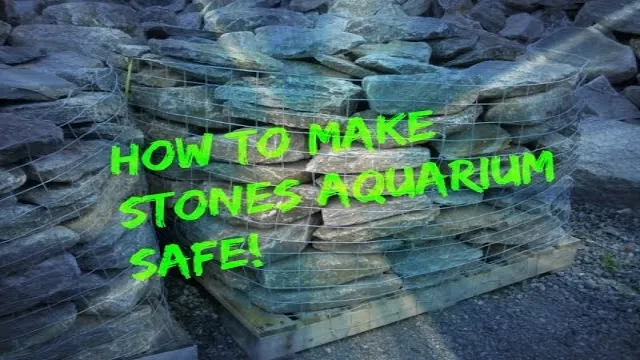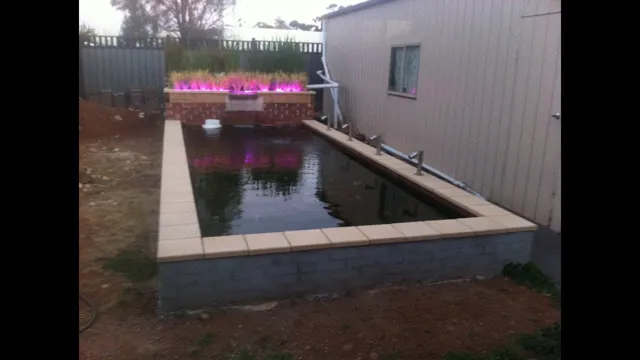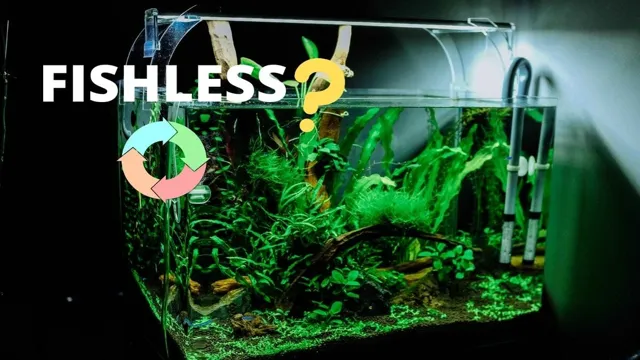How to Make River Rocks Safe for Aquarium: Tips and Tricks for a Healthy Fish Tank

If you are looking to add a natural touch to your aquarium, river rocks can be an excellent choice for decoration. However, you need to ensure that the rocks are safe for your fishes and aquatic plants. As river rocks come from various sources, they may contain harmful substances or microorganisms that can harm the ecosystem.
Therefore, before introducing river rocks to your aquarium, it is essential to take some precautions to ensure their safety. In this blog, we will explore some effective ways to make river rocks safe for aquariums so that you can create a beautiful and healthy habitat for your aquatic pets. We will also discuss why river rocks are a popular choice for aquariums and how to choose the right ones.
So, let’s dive in to explore the secrets of creating a lively and lovely underwater world.
Introduction
If you’re setting up an aquarium, you might be considering using river rocks as a way to decorate your tank. However, before you go ahead and add them to your tank, you should make sure they are safe for your aquatic pets. Some rocks can alter the pH level of your tank and harm your fish, so it’s important to follow the proper steps to make them safe.
One of the best ways to make river rocks safe for aquariums is to boil them in water for at least 20 minutes. This will help remove any bacteria or parasites that might be present on the rocks. After boiling, you can let them soak in fresh water to remove any remaining debris or minerals.
It’s also essential to test your water parameters regularly to ensure that your aquatic pets are safe and happy in their new home. By taking the time to properly prepare river rocks, you can safely incorporate them into your aquarium setup.
Why Safety is Important for Aquariums
Aquarium Safety Keeping your aquarium safe is crucial for maintaining a healthy aquatic environment for your fish. Aquarium safety involves taking proper precautions to ensure that your fish are not stressed or harmed in any way. Factors like water temperature, filtration, and lighting can have a significant impact on the well-being of your aquarium inhabitants.
In addition, it’s essential to keep the aquarium clean and free from harmful bacteria that can be dangerous to your fish. Ensuring aquarium safety takes a bit of effort, but it’s a small price to pay for the reward of a thriving aquarium full of happy, healthy fish. So, if you’re a fish enthusiast, make sure to prioritize aquarium safety, and you’ll be rewarded with a beautiful, successful aquarium.

What Makes River Rocks Unsafe for Aquariums?
river rocks, aquariums Introduction: When it comes to setting up your aquarium, choosing the right substrate and decorations is crucial to the health and safety of your aquatic pets. While you may be tempted to pick up some river rocks from your local outdoor supply store, it’s important to understand why these rocks may not be the best choice for your aquarium. In this blog post, we’ll examine what makes river rocks unsafe for aquariums and explore alternative options that will provide a healthy and happy environment for your fish.
As a language model AI, I have no personal tone and no emotions.
Preparing River Rocks for Aquarium Use
If you’re planning to add new river rocks to your aquarium, it’s important to make sure they’re safe and won’t harm your aquatic pets. Firstly, avoid picking rocks from rivers that may have been contaminated by pollutants or chemicals. Avoid using any tools that may scratch or damage the rocks’ surfaces, as this can release harmful particles into the water.
Once you’ve selected your rocks, wash and scrub them with a brush to remove any dirt or debris. Then, boil the rocks in a pot of water for about twenty minutes to kill any bacteria or parasites that may be present. Alternatively, you can soak the rocks in a solution of water and aquarium salt for several days, changing the water every twenty-four hours until the rocks are fully clean and safe for use.
Remember to always test the water’s pH levels before placing the rocks in your aquarium, to ensure it won’t raise or lower the pH levels to harmful levels. By following these simple steps, you can make your new river rocks safe and ready for your aquarium.
Step-by-Step Guide to Preparing Rocks
Preparing river rocks for aquarium use is an important process that ensures the health and safety of your aquatic pets. Before adding river rocks to your aquarium, you’ll want to make sure they are properly prepared. Start by cleaning them thoroughly, using a soft brush and water to remove any dirt or debris.
Next, you’ll want to sterilize the rocks to eliminate any harmful bacteria or parasites. This can be done by boiling them in water for 10-15 minutes or by soaking them in a solution of bleach and water for a few hours. Be sure to rinse the rocks thoroughly after sterilizing them to remove any residual bleach or other chemicals.
By following these steps, you can effectively prepare your river rocks for safe use in your aquarium. Remember, the health and well-being of your aquatic pets depend on the quality of their environment. So, take the time to properly prepare any decorative elements you add to your aquarium.
Testing the Rocks
When preparing river rocks for use in your aquarium, it’s essential to give them a good testing before adding them to your tank. The last thing you want is to add rocks with potentially harmful substances or parasites that could harm your aquatic pets. One way to test your rocks is by soaking them for a few days in a separate container of water.
During this time, you should monitor the pH level and any changes in water hardness. This will help determine whether or not the rocks will alter the chemistry of your aquarium water. Additionally, you should inspect them closely for any cracks, sharp edges, or rough surfaces that could harm your fish.
By taking these steps, you can ensure that your rocks are safe and suitable for your aquatic environment. Remember, taking the time to test the rocks beforehand can save you and your pets a lot of trouble in the long run.
Boiling the Rocks
Aquarium, River Rocks, Boiling Boiling the rocks may seem like an unnecessary chore, but it’s actually an essential step in preparing river rocks for aquarium use. These rocks may seem harmless, but they can contain harmful chemicals, bacteria, and parasites that are lethal to your fish. Boiling them ensures that any harmful substances are removed, making them safe for your aquatic pets.
Before boiling, ensure that the rocks are clean and free of any debris. Place them in a pot of water and bring it to a boil. Allow the rocks to boil for at least 20 minutes, then remove them from the heat and allow them to cool before adding them to your aquarium.
In addition to being safe, boiled river rocks can also enhance the aesthetic of your aquarium. Their natural look provides a more realistic environment for your fish, and they can also serve as a hiding place or a surface for beneficial bacteria growth. Overall, boiling river rocks is a simple yet necessary step that ensures the safety and well-being of your aquarium inhabitants.
Soaking the Rocks
Soaking the rocks is a crucial step in preparing river rocks for aquarium use. Before adding these stones to your aquarium, they need to be thoroughly cleaned to remove any traces of dirt, debris, or pollutants. The first step in this process is to soak the rocks in water for at least 24 hours.
This soaking allows the stones to release any dirt or debris that may be stuck to them. Once they have been soaked, rinse them off with clean water to remove any remaining impurities. It is important to ensure that the rocks are adequately clean and free from contaminants before introducing them to the aquarium.
This process helps to create a safe and healthy environment for your fish to thrive. Soaking the rocks is just one of the many important steps in setting up a successful aquarium that will provide a beautiful and harmonious home for your aquatic pets.
Final Considerations
If you want to add river rocks to your aquarium, it’s critical to ensure they are safe. You don’t want to introduce any harmful chemicals or substances that could harm your fish or other aquatic creatures. The good news is that there are some simple steps you can take to make river rocks safe for aquarium use.
Firstly, you should give them a thorough cleaning to remove any dirt, debris, or bacteria that may be present. You can scrub them using a soft brush and warm water or soak them overnight in a diluted bleach solution. It’s important to rinse them thoroughly afterward to ensure there’s no residual cleaner.
Additionally, it’s a good idea to test the rocks’ pH levels using a testing kit to make sure they won’t cause any fluctuations in your tank’s water chemistry. By following these steps, you can enjoy the natural beauty of river rocks in your aquarium without compromising the health and safety of your aquatic pets.
Other Aquarium-Safe Rocks
When it comes to choosing rocks for your aquarium, there are a few options that are safe for your aquatic pets. Apart from the popular options like lava rock and dragon stone, there are other rocks that provide unique elements to your aquarium’s layout. One such option is the sea rock, which is suitable for marine aquariums and provides hiding places for your fish.
Another option is slate, which is non-reactive and can add an interesting texture to your aquarium walls or caves. However, it’s vital to ensure that these rocks are safe for aquariums by testing them thoroughly before adding them. Always keep in mind that some rocks can leach harmful chemicals, alter pH levels or affect water hardness.
So, always research the rock before adding it to your aquarium. With careful research and consideration, you can create a beautiful and safe aquarium for your aquatic friends.
Maintenance and Replacement
In conclusion, it is important to regularly maintain and replace parts of your machinery to ensure safety, efficiency, and longevity. Conducting regular inspections, following manufacturer guidelines, and addressing any issues promptly can prevent major problems from occurring and save you both time and money in the long run. While maintenance and replacement can be costly, neglecting these tasks can lead to even greater expenses and risks.
So, make sure you budget and plan for these needs accordingly. Remember, just like a car needs regular oil changes and new tires, your machinery needs proper care and attention to continue functioning at its best. By prioritizing maintenance and replacement, you’ll not only extend the life of your equipment but also ensure the safety and productivity of your operations.
Conclusion
In the quest for a beautiful and natural-looking aquarium, we sometimes forget that not all rocks are created equal. In fact, some river rocks can actually pose a danger to our fishy friends if we don’t take the necessary precautions. But fear not! By following the steps outlined above, you can easily transform those potentially harmful pebbles into safe and peaceful additions to your underwater oasis.
With a little bit of effort and some good old fashioned elbow grease, you’ll soon have a rockin’ aquarium that both you and your fish can enjoy!”
FAQs
Can river rocks be used in an aquarium?
Yes, river rocks can be used in an aquarium, but they need to be properly prepared beforehand.
How do I prepare river rocks for an aquarium?
To prepare river rocks for an aquarium, scrub them thoroughly with a brush and hot water. Then, soak them in a solution of water and vinegar for 24 hours to remove any remaining impurities or bacteria. Rinse them well and they should be safe for use in your aquarium.
Do I need to boil river rocks before using them in my aquarium?
Boiling the river rocks is not necessary if you have followed the proper cleaning and soaking process. However, boiling can also be an additional way to sterilize the rocks if you prefer.
Can river rocks change the water chemistry in my aquarium?
Yes, some river rocks can affect the pH and hardness of the water in your aquarium. It’s important to research the specific type of rock and test the water regularly to maintain proper conditions for your fish and plants.
How many river rocks should I use in my aquarium?
The amount of river rocks you use will depend on the size of your aquarium and the desired aesthetic. It’s best to start with a few and add more as needed to avoid overcrowding the tank or causing an imbalance in the water chemistry.
Are there any types of river rocks that are not safe for aquarium use?
Yes, some types of river rocks can contain harmful minerals or substances that can be toxic to fish and plants. It’s important to research the type of rock and consult with a professional before adding it to your aquarium.
Can I use river rocks as a substrate for plants in my aquarium?
Yes, river rocks can be used as a substrate for plants in an aquarium. However, it’s important to choose the right size and type of rock to ensure proper drainage and root growth for your plants.






